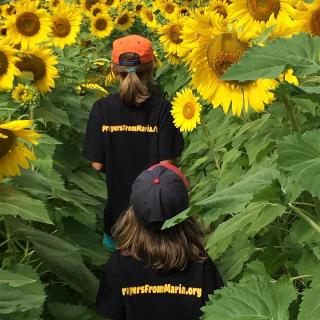Oct 28 2014
Prayers from Maria Children's Glioma Cancer Foundation announced today that it will award its $250,000 Melana Matson Memorial Grant—its third major research grant since 2010—to Case Western Reserve University, Case Comprehensive Cancer Center researchers James Basilion, PhD, Efstathis Karathanasis, PhD, and John Letterio, MD, who are studying the use of nanotechnology to more effectively treat pediatric glioma brain tumors.
 The Sunflower Soiree Festival raises approximately $200,000 to fund children's glioma research for the Prayers from Maria Children's Glioma Cancer Foundation. Credit: Rachael Stalzer
The Sunflower Soiree Festival raises approximately $200,000 to fund children's glioma research for the Prayers from Maria Children's Glioma Cancer Foundation. Credit: Rachael Stalzer
"We are tremendously happy to award this grant to the research team at Case," said Ed McNamara, foundation president and co-founder. "When Maria was diagnosed with a brain stem glioma back in 2006, we quickly learned how little was being done for these children and how treatments for these types of tumors had not advanced in almost 40 years. This research brings us one step closer to the development of more targeted and less toxic treatment strategies." Megan McNamara, co-founder, added "We are especially excited to have partnered with Friends of Melana, started by Norm and Joyce Fashing in honor of their granddaughter Melana Matson, to raise these critical funds. I can't think of a better way to honor the memories of Maria and Melana than to help bring more effective and promising treatments to children battling gliomas."
"Pediatric therapies often follow the oversimplified assumption that children are just smaller people," said Efstathios Karathanasis, Assistant Professor, Biomedical Engineering and Radiology at CWRU. "We now know that scaling down the dose of existing drugs will not achieve eradication of this lethal disease, so this award from Prayers from Maria provides us with the opportunity to develop a therapeutic agent specifically for children battling gliomas.Working with a collaborative team of researchers with complementary expertise – in this case – cancer nanotechnology, pediatric oncology and molecular pharmacology – holds great promise,"stated Karathanasis."
"We are excited to be associated with the Prayers from Maria Foundation," said James Basilion,Professor, Radiology, Biomedical Engineering at CWRU. "There are almost no funding opportunities for childhood brain tumors, yet the impact on these children and families is huge. I am excited that Ed and Megan have taken up this cause and I think that the group will drive forward research for this disease. We have worked as a team at Case for quite some time, and what has emerged is an ability to treat tumors more effectively with less side effects, which fulfills the unmet clinical need for childhood brain tumors. We are grateful to have the opportunity to apply this technology to childhood brain tumors," said Basilion.
Currently, pediatric brain tumors are nearly inaccessible with today's drugs regiments. This stems from the fact that drugs are not specifically designed to consider the uniqueness of pediatric brain tumors. To effectively seek and treat pediatric gliomas, Dr. Karathanasis and his colleagues have designed a new nanoparticle to "smuggle" the drug into these tumors. The nanoparticle, called nanochain, is made of different nanospheres connected one to another in a linear fashion, like the links of a chain. Specifically, the research team links three nanospheres made of iron oxide and one lipid nanosphere filled with drugs. The surface of the nanochain is 'decorated' with multiple sites that act like glue to bind explicitly to the blood vessel lining where brain tumors are located. Due to their shape and flexibility, the nanochains possess a unique ability to drift out of the blood stream and hone in on cancer markers along the blood vessel walls and adhere to the site. This places the nanochain directly next to the tumor, separated only by the blood vessel wall. Once the nanochains slip from the blood stream and dock onto the blood vessels of gliomas, a mild radio frequency (RF) field is applied outside the body (similar to a FM radio). The field causes the tails of the nanochain to vibrate, breaking open the lipid drug spheres, and creating a rapid release of a free drug capable of spreading throughout the entire tumor site. Preclinical studies have shown that a remarkable 5% of the injected dose accumulates in gliomas compared to current treatment methods that only achieve less than 1% penetration of the dose. As noted by Dr. Karathanasis, "We hope to see promising results like this for the pediatric brain cancers, and funding support from the Prayers from Maria Foundation will make this important research possible."